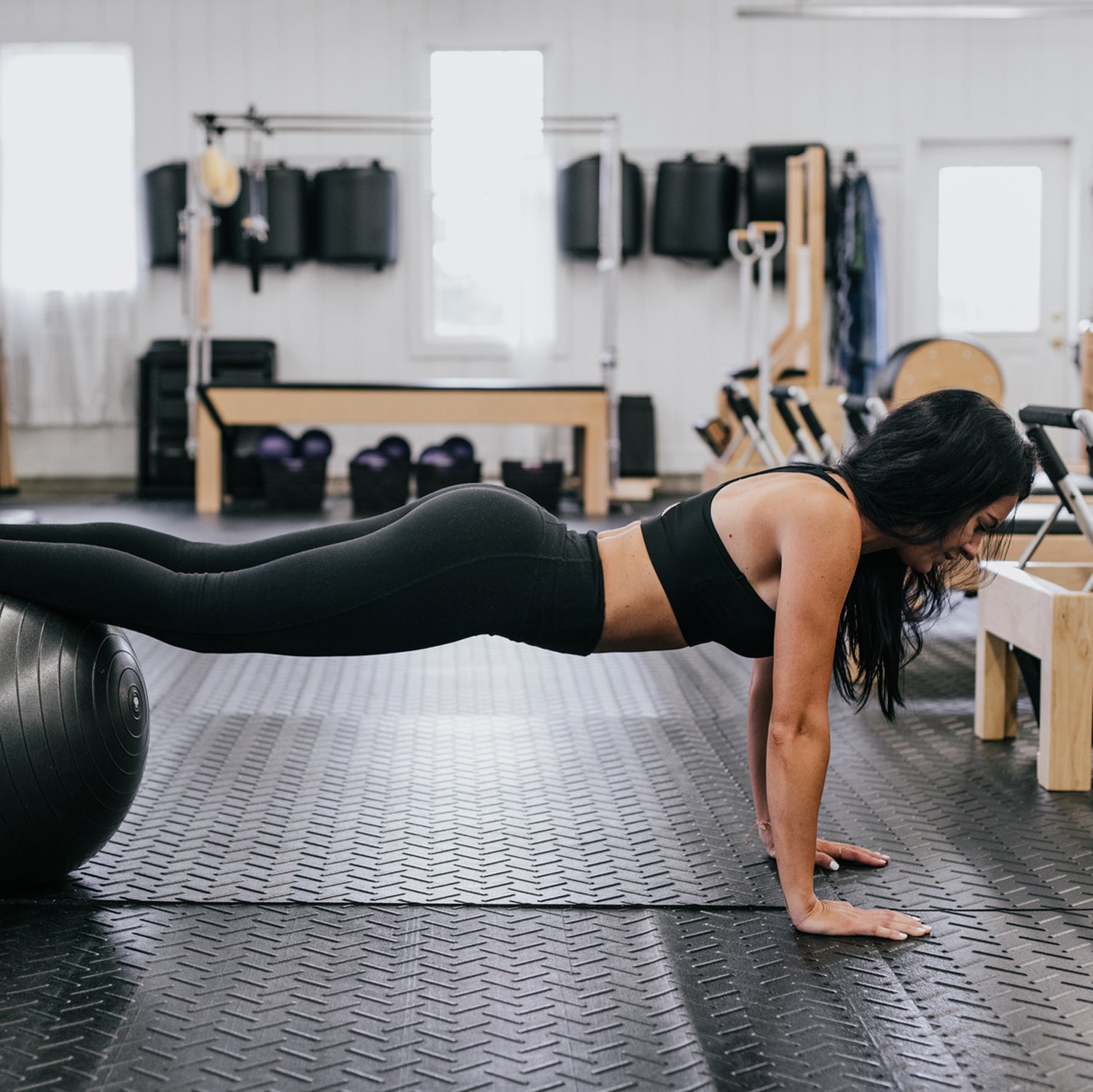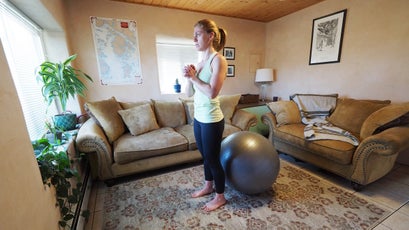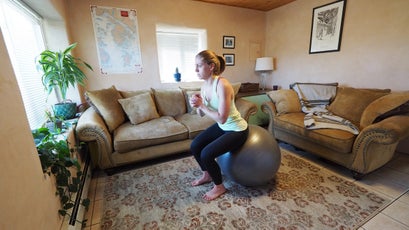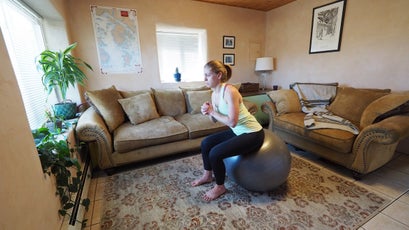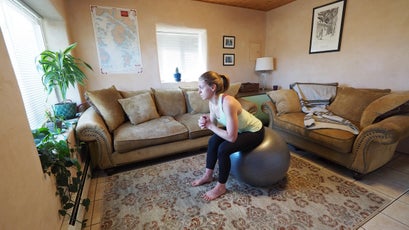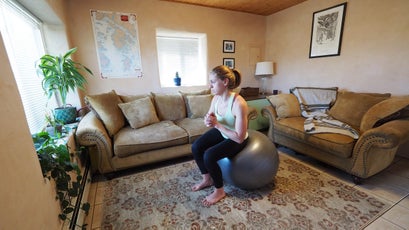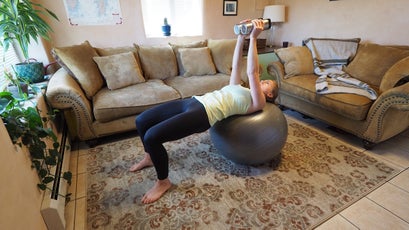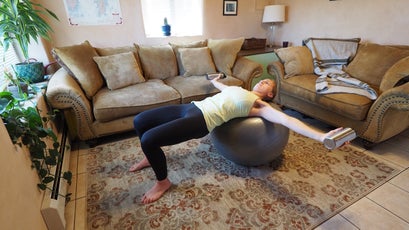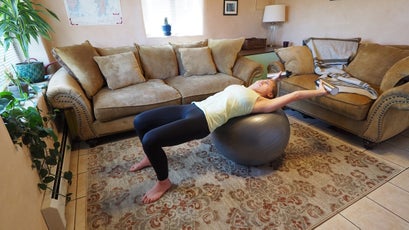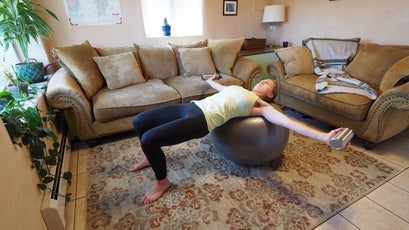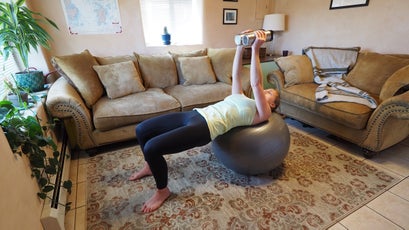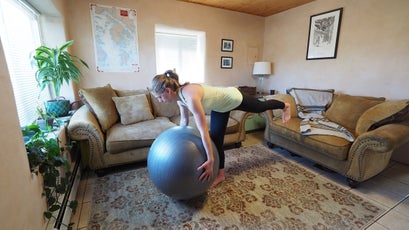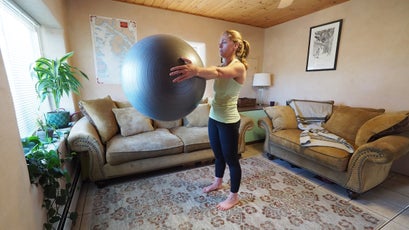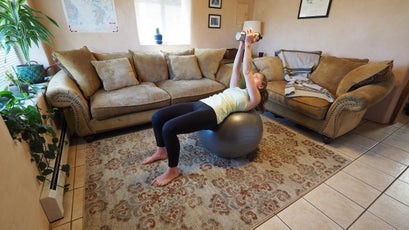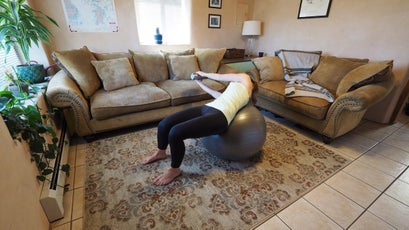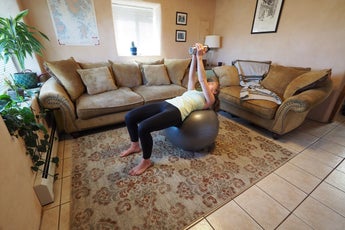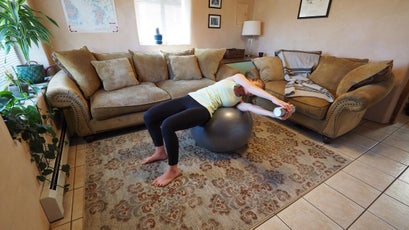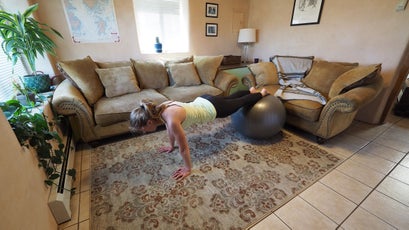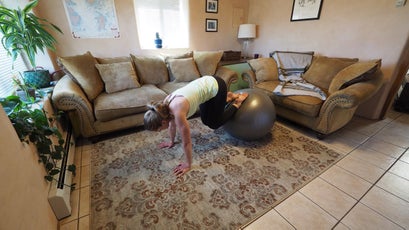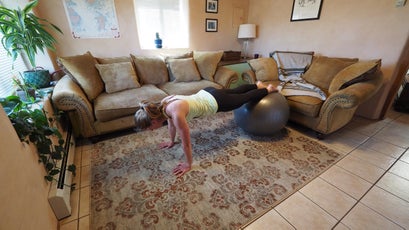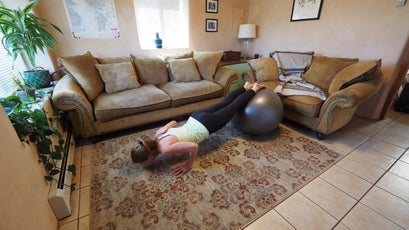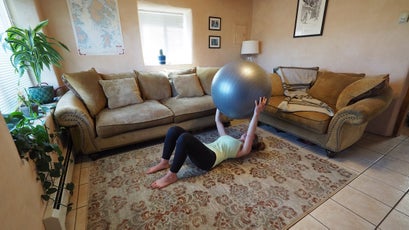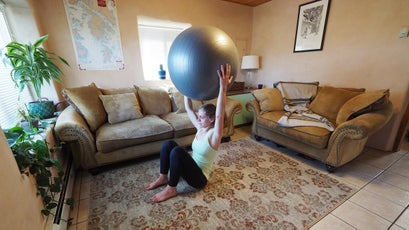Stability balls—also known as exercise, fitness, or Swiss balls—are a home-gym staple. But more often than not, they end up sitting useless in the corner of spare rooms, deflated in closets, or becoming repurposed as desk chairs. As gyms remain closed or open at reduced capacity, now is the perfect time to finally put this tool to use.
We asked Kathleen Stabler, a fully certified Gym Jones instructor and the owner of True North Performance Coaching in Albuquerque, New Mexico, to create a core-centric, full-body stability ball workout for outdoor and endurance athletes. Do this routine two to three times per week, completing the exercises in order. “Really pay attention to form to make the most out of these moves,” Stabler says. “As with all of my workouts, this one is a lot harder than it looks.”
Stability balls typically come in five diameters of ten-centimeter increments, ranging from 45 centimeters (18 inches) to 85 centimeters (34 inches). As a general rule, when you sit on the ball, with your feet on the floor, you want your knees to be bent to 90 degrees. “It’s important to have the right-size ball,” Stabler notes, “but since we’re in the middle of a pandemic, this workout can be done with whatever you have handy.”
The Warm-Up
Complete five rounds of this mini circuit, with no rest between exercises or sets. Gradually increase your speed and intensity each time through, and try to improve your efficiency and agility in the up-and-down transitions between movements.
-
Bear crawl: 50 feet forward, then 50 feet backward.
-
Run: 50 feet forward, then 50 feet backward. (You may need to go outside for this one.)
The Moves
Squat Circles
What they do: Warm up the big leg muscles (quads, glutes, and hamstrings) that will be used throughout the workout, activate the core, and increase mobility in the torso and pelvis.
How to do them: Stand in front of the exercise ball, facing away from it, with your feet shoulder-width apart. Engage your core, then squat (see: how to squat properly) until your hips touch the edge of the ball. Partially weight the ball, but keep your feet grounded, your core strong, and your glutes engaged. Then work your hips in clockwise circles, completing a full range of motion as wide as you can go with good form. Alternate between clockwise and counterclockwise directions each rep.
Volume: Two to three sets of ten repetitions in each direction.
Shoulder Fly and Snow Angels
What they do: Strengthen the chest, shoulders, upper back, core, and glutes and improve mobility in the shoulders.
How to do them: This exercise pairs two arm movements, one on a vertical plane and the other on a horizontal plane. Lie on your back, with your head and shoulders supported by the ball, your knees bent, and your feet flat on the floor. Engage your core and glutes to hold up your hips, with your thighs and torso forming a straight line parallel to the floor. Start with your arms extended above you, with a slight bend in the elbows and your palms together and centered over your chest. Lower your arms out to the sides until they’re parallel to the floor. Then pivot your arms overhead, parallel to the floor, like you’re doing a snow angel or you’re Da Vinci’s Vitruvian Man. Go as far as your shoulder mobility allows, which might be different between sides, says Stabler. Reverse each movement back to the starting position for one repetition. Hold water bottles or free weights to make it harder.
Volume: Three sets of seven reps for each movement.
Single-Leg Straight-Leg Deadlift
What it does: Strengthens the hamstrings, glutes, and core while training balance.
How to do it: Hold the ball overhead, and squeeze it between the palms of your hands to engage your shoulders and upper back. If the ball is too big for you, hold it in front of your chest. Stand on one leg, with a slight bend in your knee. Square your hips, engage your core, then slowly hinge forward at the hips, lifting your free leg behind you until your torso and leg are parallel to the floor (or go as far as you can with good form). Reverse the movement for one repetition. Keep your hips level, your raised foot pointed toward the floor, and your back straight throughout the movement. Focus on leg control and balance.
Volume: Four sets of six reps on each leg. Complete all reps on one side, then switch to the other. Since you’re resting one leg while you’re using the other, there’s no need to rest between sets.
Complete the next three exercises as a mini circuit, cycling from one to the next in order, with no rest between exercises. Complete four rounds total, with one minute of rest between each round. Focus on slow and controlled movements.
Eccentric Squats
What they do: Strengthen the quads, glutes, hamstrings, calves, and core by emphasizing the eccentric phase of the movement (lowering). They also engage the shoulders and upper-back muscles.
How to do them: Hold the ball four to six inches in front of your chest, squeezing it between your palms. Stand with your feet shoulder-width apart or slightly wider. Hold your chest and head high, pull your shoulders back and down, and keep your spine stacked in a neutral position. Then bend your knees and hinge forward at the hips to lower into a squat for three seconds. Stop when your thighs are roughly parallel to the floor (or as low as you can go with good form), and hold this low position for another three seconds. Then engage your glutes, and push through your heels to stand. Keep the ball steady throughout the movement.
Volume: Four sets of twelve reps.
Crunches
What they do: Strengthen the abs.
How to do them: Lie on your back on the ball, with your knees bent and your feet flat on the floor shoulder-width apart. Place your hands behind your head to support your neck, with your elbows out wide. Adjust your position so that your hips are on the edge of the ball, with your lower back supported. Then engage your core, and sit up partway. Slowly reverse the movement to the starting position for one repetition.
Volume: Four sets of twelve reps.
Russian Twists
What they do: Strengthen the core muscles, with an emphasis on the obliques.
How to do them: Begin from the same starting position as the crunches above, but clasp your hands together or hold a weight (such as a kettlebell or a gallon jug of water) above your chest. Then twist your torso and arms to one side. Rotate your shoulders to follow your hands, and resist any movement in your hips and legs. Reverse the movement back to center, then twist to the other side. Continue rotating side to side, moving slowly and in control. For an extra challenge, lift the opposite foot for each rep: for example, if you twist to the right, lift the left foot.
Volume: Four sets of six reps per side.
Knee Tuck plus Push-Up Ladder
What it does: Strengthens the core, chest, triceps, shoulders, and back muscles.
How to do it: This exercise combines two movements. Start in a standard push-up position, with your arms straight, your hands below your shoulders, and your feet together on top of the exercise ball (or place your shins on the ball to make it easier). Hold your body in a rigid plank from your heels to your head. Then tuck your knees into your chest as you roll the ball forward. Reverse the movement back to the starting position. Then complete a full push-up. Begin with one knee tuck followed by one push-up, then do two knee tucks and two push-ups, three knee tucks and three push-ups, all the way up to ten reps in a row for each movement. Keep your core and back engaged throughout.
Volume: One to ten rep ladders of each movement. If this is too difficult, break it up into two sets of one to five ladders, with one to two minutes of rest between sets.
Get-Up Sit-Up
How to do it: Lie on your back on the floor, with your knees bent and your feet flat. Hold the ball with straight arms over your chest in a bench-press position. Then sit up, simultaneously lifting the ball overhead in one fluid motion. Slowly reverse the movement back to the starting position for one repetition.
Volume: 30 reps (or break it into three sets of ten reps, with one minute of rest between sets). Do more if you’re psyched.

